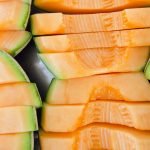Here’s one from the “everything you eat might kill you” department. A new study links consumption of citrus–and specifically whole grapefruits and orange juice–with melanoma.1 Fuller, Steven. “Citrus consumption may be linked to increased melanoma risk.” 1 July 2015. UPI. 2 July 2015. http://www.upi.com/Health_News/2015/07/01/Citrus-consumption-may-be-linked-to-increased-melanoma-risk/5011435758692/ It’s not just a tiny correlation, either. Those who drink moderate amounts of OJ or enjoy grapefruit daily stand a 36 percent increased risk of developing the skin cancer compared to those who eat only a little citrus a few times a week.
The study, out of Brown University Medical School in Providence, Rhode Island, followed more than 100,000 adults over a 26-year period from 1984 to 2010. They controlled for age, vitamin C supplement intake, smoking history, and so on. The more grapefruit and OJ subjects had, the greater their melanoma risk. Those who had about five citrus servings a week had a 25 percent increased risk. But those who had a daily serving and a half of citrus upped the risk to 36 percent. Grapefruit was considerably worse than orange juice, upping the melanoma risk by 41 percent for those who had 1.5 servings a day, whereas OJ “only” escalated melanoma incidence by 25 percent.
The study defined a serving as either half a grapefruit or six ounces of orange juice. That means that if you enjoy a tall glass of juice with breakfast daily, you’re well into the danger zone; if you have just a small juice glass, you still have some increased risk. Paradoxically, grapefruit juice didn’t correlate to increased risk; nor did eating whole oranges. People who sunburned easily were the most affected.
Why would citrus increase melanoma incidence? Apparently, citrus makes the skin more sensitive to the sun. That’s because citrus contains high levels of furocoumarins, also known as psoralens, which are photoactive substances that become toxic when exposed to sunlight.2 Osterwell, Neil. “Citrus Fruit and Melanoma: Is There any Link?” 30 June 2015. Medscape Multispeciality. 2 July 2015. http://www.medscape.com/viewarticle/847208 It’s thought that psoralens protect plants from fungal attack. The problem comes when you ingest foods containing psoralen and then go out in the sun. In fact, even handling foods rich in psoralen increases your risk, since psoralen residue collects on the skin, increasing the chance that you’ll develop not only melanoma in areas of contact, but also age spots, dermatitis, or severe sunburn.
If you live in Seattle where it rains most of the year, you probably don’t need to worry about your greedy grapefruit habit as much as someone who lives in Florida and stays outdoors a lot. Nor do you need to worry as much if you don’t burn easily. Obviously, the problem is more pronounced in summer than winter.
It’s the very same photosensitizing properties escalating cancer risk that some enterprising souls have found a use for. Dermatologists use psoralens to treat people suffering from eczema or psoriasis, essentially burning the trouble off, and the FDA has approved a treatment using psoralens in combination with ultraviolet light for this purpose in spite of the dangers. In the past, psoralens were a common ingredient in suntan lotions, too.
According to study director Dr. Abrar Quereshi, “Psoralens had been used as tanning activators until 1996, and individuals who used psoralen tanning activators had a higher risk of melanoma. Psoralen-containing sunscreen users also had a substantially increased risk of melanoma as compared with regular sunscreen users. As a result, strict regulations have been imposed on psoralen-containing suntan lotions and cosmetic products in recent years.”
In fact, though, plenty of cosmetic and hair care products still on the market contain citrus oils, and the safety of these products is subject to debate. You might want to check labels, even in your natural products.
If you eschew grapefruit and orange juice, you’re hardly safe from psoralens. The substance also abounds in lemons, limes, carrots, celery, figs, anise seed, caraway, cilantro, cumin, coriander, dill, fennel, parsnips, and parsley.3 “Foods that Contain Psoralen.” Healthwatch.Org. 2 July 2015. http://www.healwithfood.org/foods-that-contain/psoralen.php Should you give up citrus, parsley and figs and fennel, too? Or should you buy a can of spray suntan lotion to keep yourself safe from UV radiation?
The study needs to be taken in context. First of all, citrus has loads of vitamin C, potassium, folate, and phytochemicals, and these ingredients offer some protection against cancer and cardiovascular disease.4 Economos, C. and Clay, W.D. “Nutritional and health benefits of citrus fruits.” FAO Corporate Document Repository. 3 July 2015. http://www.fao.org/docrep/x2650t/x2650t03.htm All of the foods on the “bad” psoralen list have counterbalancing components. Also, the study has drawn plenty of criticism for being unreliable, based on the fact that correlation doesn’t equal causality and that the results didn’t exactly add up given such facts as that grapefruits spiked melanoma risk so much, but not grapefruit juice. That doesn’t make sense. The bottom line here is to exercise restraint, but not avoidance.
Dr. Qureshi says, “We are NOT recommending changing fruit consumption as these fruits and vegetables are important for overall health. However, until we learn more about these furocoumarins, those consuming fresh citrus fruits on a regular basis should be extra careful with sun exposure, and, depending on their outdoor activities, they should wear appropriate sunscreen, hats and sun-protective clothing.”
That’s sound advice, particularly on days when the UV index is high and particularly if you’re sun sensitive. It’s never wise to parade around in blazing sun unprotected for long stretches of time, and now you know that eating a lot of psoralen-rich foods makes that advice doubly important. Make sure, by the way, that the sunscreen you use is on the Skin Deep database of best sunscreens.5 http://www.ewg.org/2015sunscreen/ Oh, and just to make things really confusing, remember that the more sunscreen you use, the less vitamin D production you get. You just can’t win.
References
| ↑1 | Fuller, Steven. “Citrus consumption may be linked to increased melanoma risk.” 1 July 2015. UPI. 2 July 2015. http://www.upi.com/Health_News/2015/07/01/Citrus-consumption-may-be-linked-to-increased-melanoma-risk/5011435758692/ |
|---|---|
| ↑2 | Osterwell, Neil. “Citrus Fruit and Melanoma: Is There any Link?” 30 June 2015. Medscape Multispeciality. 2 July 2015. http://www.medscape.com/viewarticle/847208 |
| ↑3 | “Foods that Contain Psoralen.” Healthwatch.Org. 2 July 2015. http://www.healwithfood.org/foods-that-contain/psoralen.php |
| ↑4 | Economos, C. and Clay, W.D. “Nutritional and health benefits of citrus fruits.” FAO Corporate Document Repository. 3 July 2015. http://www.fao.org/docrep/x2650t/x2650t03.htm |
| ↑5 | http://www.ewg.org/2015sunscreen/ |












I wonder if some of this is
I wonder if some of this is because of the upping of phase I enzymes with oranges of grapefruit so that our phase II has a harder time with psoralens. Maybe eat some broccoli with your orange?
Really good article and
Really good article and thanks for the balanced discussion. Two thoughts strike me, I was not aware of the issue with psoralen’s, and their effects on skin sensitization. Especially for the fair skinned, and those of us who look at all issues pertaining to safe sun exposure. 2nd, I’m sure the sugar content of the fruit juices was not considered, nor the actual amount then of the psoralen’s consumed in juice versus the whole fruit. Both of these issues must have an impact, especially if the juices are further sweetened. My guess is not all in the study where squeezing fresh grapefruit and or oranges. So not all fruit juice is created equal, and devoid of the fiber, juice is always inferior to whole fruit consumption.
Sounds utterly ridiculous.
Sounds utterly ridiculous. So you eat these herbs, fruits etc. and stay out of the sun further leaving you with low Vitamin D levels, a cancer protection. Or you slather on chemicals on your skin. Those who fall prey to melanoma probably have low D levels anyway, and the sun is not the cause of melanoma. It is found in areas that do not receive sunlight like between toes. Just another health scare to ruin a day. Moderation in all things!!! Judith Fenton
The article says eating whole
The article says eating whole grapefruit is worse in the summer. Where can anyone find grapefruit in the summer? They ripen mid-winter. Nature knows best. Eat fruit when it comes off the tree.